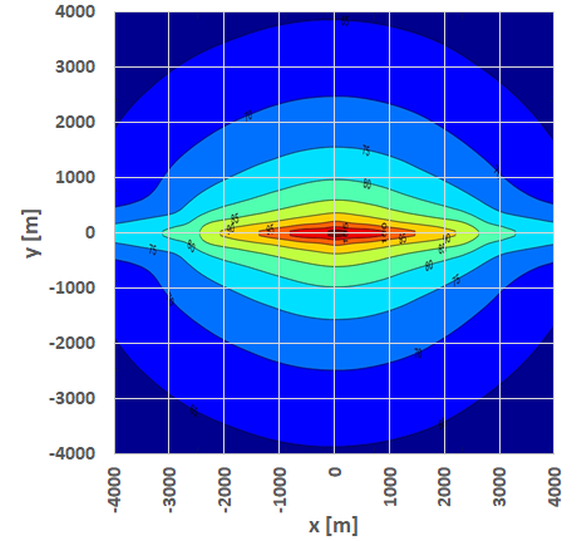Noise Source Modelling, Flyover Simulations, Aircraft Auralization - FLYO®
REGISTERED AT EUIPO ON 21/06/2019 under No.018017579
FLYO® represents a complete tool-chain of source modelling, computation of sound propagation for complex community aircraft noise scerios and auralization for single flyover events. The software allows multiple selections of source combinations and noise metrics to be computed for situations with more than 1,000,000 aircraft movements over longer periods of time.
Main Features
- > 900 a/c types or attitudes with total > 4.000 single noise sources
- each monopole source characterised by LW(f) and DI(j,q)
- > 100 flight paths, each several thousand segments
- > 900 a/c types per path, each with 3 possible time periods for operating (day/evening/ night) and individual velocity
- max. 999 a/c per type on each path (approx. 8 Mio events per scenario)
- transient operations (e.g., tilt-wing approach to vertiport)
- up to 1,000,000 observer points (imported or pre-defined grid)
- computation in Octaves (31.5 – 16,000 Hz) or 1/3-Octaves (20 Hz – 20,000 Hz)
- A/B/C/D frequency weighting or linear SPL spectra
- > 10 noise metrics implemented
- program environment: Windows 10/11 or macOS 11
Main Output
- Averaged SPL per a/c in scenario (spectral if no grid compuation)
- Computation grid (geometry)
- Level vs. Time per a/c type, path and obeserver (single events only)
- Level vs. Time per noise source
- Averaged SPL spectrum per a/c type for each path and oberver
- Averaged SPL per path for each observer (spectral if no grid computation)
- Averaged SPL for complete scenario for each observer (spectral if no grid computation)
- SEL per a/c type on each path for each observer
- Areas [km2] for SPL per a/c type, path, overall scenario and selected metrics < 20 dB, 20-30 dB, 30-40 dB … > 90 dB (grid/map computation)
- Level (spectrum) vs. Time for each a/c type, each path at each observer
- Flyover spectra for transient operations (e.g. full footpring of single aircraft)
- Special metrics for overall scenario (including grid/map computations)
- Loudness and Sharpness (single event at each observer)
- Check file (for plausibility check of sound propagation for each source, path and observer)
- Restart file
- Log file


Examples: Noise map for greater Munich aera in the presence of UAM air traffic (left) and noise footprint for a tilt-wing airtaxi at a generic vertiport (right).
[Topografic map: Bayerische Vermessungsverwaltung – www.geodaten.bayern.de“, Creative Commons Namensnennung 3.0 Deutschland Lizenz (CC BY 3.0 DE)]
Aircraft Noise Source Modeling (plugin module of FLYO®)
The following sources and their components can be simulated using well-established semi-empiric methods:
Fan Noise
- Inlet Broadband Noise
- Inlet Tone Noise
- Combination Tones
- Aft Broadband Noise
- Aft Tone Noise
Jet Noise
- Small Scale Mixing Noise
- Transitional/Intermediate-Scale Mixing Noise
- Inner Stream Plug Separation Noise
- Plug/Downstream Shock Noise
- Outer Stream Shock Noise
- Inner Stream (or Single Stream) Shock Noise
Airframe Noise
- Clean wing
- Clean vertical tail
- Clean horizontal tail
- Landing Gear Noise (Nose & Main LG, i.e., 2-wheel and 4-wheel)
- Trailing Edge Flap Noise (single-, double, triple slotted)
- Leading Edge Slat and Flap Noise
Propeller Noise
- Tonal components
- Broadband noise
- Propeller with tilt angle
Helicopter Noise
- Periodic rotational noise / steady and unsteady loading (for main and tail rotor)
- Compressibility-induced profile and drag noise (main rotor)
- Thickness noise (main rotor)
- Blade vortex interaction (BVI) noise (main rotor)
- Broadband boise noise (main and tail rotor)
All of the above listed noise sources can be exported directly into FLYO® formats for further computations.
Aircraft Noise Auralization (new plugin module of FLYO®)
Munich Aeroacoustics is currently testing an own auralisation tool, aiming to generate audio files with focus on UAM air-taxis.
The auralization will be performed by using the flyover results from FLYO®.

AURA Principle.